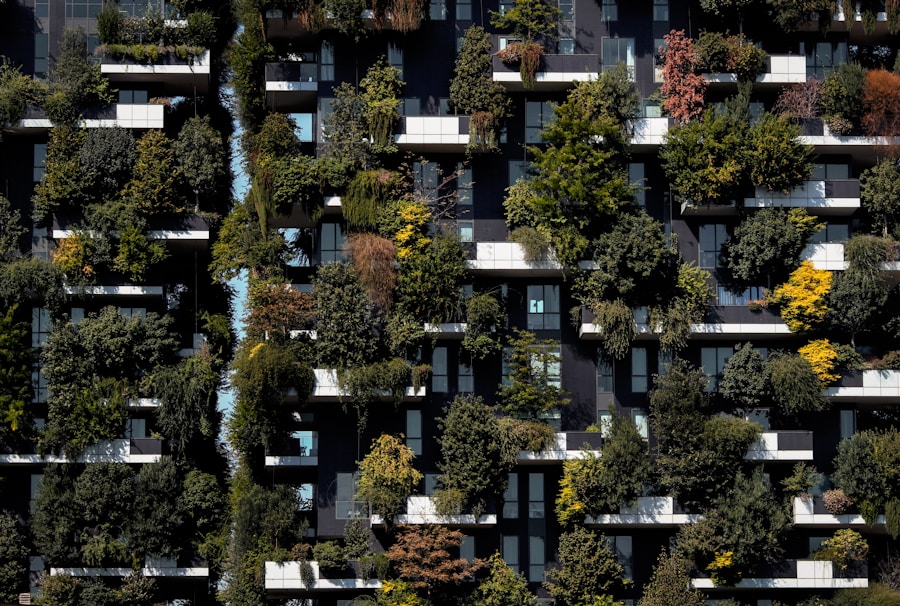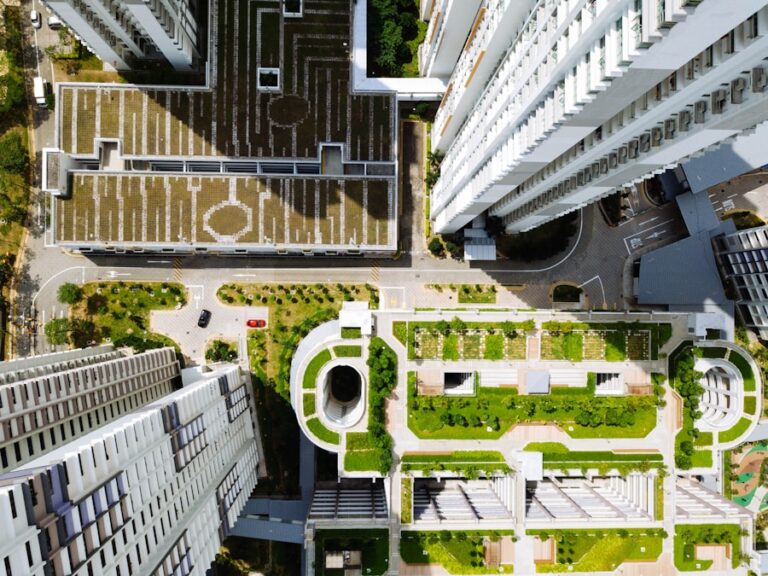Biophilic urban planning represents a transformative approach to city design that seeks to reconnect urban dwellers with nature. This concept is rooted in the understanding that humans have an inherent affinity for the natural world, a notion supported by biophilia theory, which posits that people possess an innate tendency to seek connections with nature and other forms of life. As urbanization continues to accelerate, with more than half of the global population now residing in cities, the need for integrating natural elements into urban environments has never been more pressing.
Biophilic urban planning aims to create spaces that not only accommodate human activities but also foster a sense of well-being and ecological balance. The essence of biophilic urban planning lies in its holistic approach, which encompasses various aspects of urban life, including architecture, landscape design, and community engagement. By prioritizing the inclusion of natural elements such as greenery, water features, and wildlife habitats, cities can enhance the quality of life for their residents while simultaneously addressing pressing environmental challenges.
This paradigm shift in urban planning encourages a reevaluation of how cities are designed and managed, emphasizing the importance of sustainability and resilience in the face of climate change and rapid urban growth.
Key Takeaways
- Biophilic urban planning aims to incorporate nature into urban spaces to improve the well-being of city dwellers and promote biodiversity.
- The benefits of biophilic urban planning include improved mental and physical health, increased property values, and reduced urban heat island effect.
- Incorporating nature into urban spaces can be achieved through green roofs, vertical gardens, urban parks, and natural water features.
- Promoting biodiversity in urban environments involves creating habitats for wildlife, planting native species, and implementing sustainable landscaping practices.
- Integrating biophilic design in urban infrastructure can be achieved through the use of natural materials, daylighting, and sustainable building practices.
The Benefits of Biophilic Urban Planning
Enhancing Mental Health and Well-being
One of the most significant benefits is the enhancement of mental health and well-being among urban residents. Numerous studies have shown that exposure to nature can reduce stress, anxiety, and depression while promoting overall happiness and life satisfaction.
Environmental Sustainability
By incorporating green spaces, parks, and natural elements into urban environments, cities can create restorative spaces that provide residents with opportunities for relaxation and recreation. Moreover, biophilic urban planning contributes to environmental sustainability by promoting biodiversity and reducing the urban heat island effect. Green roofs, vertical gardens, and urban forests not only improve air quality but also help mitigate the impacts of climate change by absorbing carbon dioxide and providing shade.
Practical Solutions for a Sustainable Future
Additionally, these natural features can enhance stormwater management by reducing runoff and improving water quality. As cities grapple with the challenges posed by climate change, biophilic design offers practical solutions that align with broader sustainability goals.
Incorporating Nature into Urban Spaces

Incorporating nature into urban spaces requires innovative design strategies that prioritize green infrastructure and ecological principles. One effective approach is the creation of green corridors—linear parks or pathways that connect different green spaces within a city. These corridors not only provide residents with access to nature but also facilitate wildlife movement, promoting biodiversity within urban settings.
By designing cities with interconnected green spaces, planners can create a network that enhances both ecological health and community well-being. Another strategy involves integrating natural elements into existing urban structures. For instance, transforming rooftops into green spaces or installing living walls can significantly increase the amount of greenery in densely populated areas.
These interventions not only beautify the urban landscape but also provide essential ecosystem services such as temperature regulation and air purification. Furthermore, incorporating water features like ponds or streams can enhance the aesthetic appeal of urban areas while supporting local wildlife habitats.
Promoting Biodiversity in Urban Environments
| City | Number of Green Spaces | Percentage of Tree Coverage | Number of Native Plant Species |
|---|---|---|---|
| New York City | 1,700 | 24% | Over 2,000 |
| London | 3,000 | 21% | Over 1,500 |
| Singapore | 300 | 29% | Over 2,500 |
Promoting biodiversity in urban environments is a critical aspect of biophilic urban planning. Urban areas often serve as fragmented habitats for various species, making it essential to create conditions that support diverse ecosystems. One effective method for enhancing biodiversity is through the establishment of native plant gardens and pollinator-friendly landscapes.
By selecting plants that are indigenous to the region, cities can provide food and habitat for local wildlife while reducing maintenance costs associated with non-native species. Additionally, urban planners can implement strategies such as creating wildlife corridors and preserving existing natural habitats within city limits. These corridors allow animals to move freely between fragmented habitats, reducing the risk of extinction for vulnerable species.
Furthermore, incorporating features like birdhouses, bat boxes, and insect hotels into urban designs can encourage wildlife habitation and contribute to a thriving urban ecosystem. By prioritizing biodiversity in urban planning efforts, cities can foster resilience against environmental changes while enriching the lives of their residents.
Integrating Biophilic Design in Urban Infrastructure
Integrating biophilic design into urban infrastructure involves rethinking traditional approaches to city development. This integration can manifest in various forms, from incorporating natural materials in construction to designing buildings that maximize natural light and ventilation. For example, using timber instead of concrete for structural elements not only reduces carbon emissions but also creates a warmer, more inviting atmosphere for occupants.
Additionally, designing buildings with large windows and open spaces allows for greater interaction with the surrounding environment. Moreover, transportation infrastructure can also benefit from biophilic principles. Designing pedestrian-friendly streetscapes that prioritize greenery and natural elements can encourage walking and cycling while reducing reliance on automobiles.
Incorporating trees along sidewalks not only provides shade but also enhances the overall aesthetic appeal of urban areas. By integrating biophilic design into all aspects of urban infrastructure, cities can create environments that promote health, sustainability, and community engagement.
Community Engagement and Biophilic Urban Planning

Enhancing Stewardship through Community Involvement
Fostering a sense of ownership among community members can significantly enhance the stewardship of local green spaces. When residents are actively involved in the maintenance and care of parks or gardens, they are more likely to take pride in their surroundings and advocate for their preservation. Educational programs that promote awareness about the benefits of biodiversity and sustainable practices can also empower communities to become active participants in biophilic initiatives.
Creating Inclusive Environments through Community Engagement
By prioritizing community engagement, cities can create inclusive environments that reflect the diverse needs and aspirations of their residents. This approach ensures that biophilic urban planning initiatives are tailored to the specific needs of the community, resulting in more effective and sustainable designs.
Empowering Communities through Education and Awareness
Educational programs play a vital role in empowering communities to take an active role in biophilic initiatives. By promoting awareness about the benefits of biodiversity and sustainable practices, these programs can inspire residents to become stewards of their local environment and advocate for the preservation of green spaces.
Overcoming Challenges in Implementing Biophilic Urban Planning
Despite its numerous benefits, implementing biophilic urban planning faces several challenges that must be addressed for successful integration into city development. One significant obstacle is the perception that incorporating natural elements into urban design is costly or impractical. However, many studies have demonstrated that the long-term benefits of biophilic design—such as improved public health outcomes and increased property values—often outweigh initial investment costs.
Educating stakeholders about these benefits is crucial for garnering support for biophilic initiatives. Another challenge lies in balancing development pressures with ecological considerations. As cities continue to grow, there is often a tendency to prioritize economic development over environmental sustainability.
To overcome this challenge, planners must advocate for policies that prioritize green infrastructure and biodiversity conservation alongside economic growth. Collaborating with various stakeholders—including government agencies, non-profit organizations, and community groups—can help create a unified vision for biophilic urban planning that aligns economic goals with environmental stewardship.
Case Studies of Successful Biophilic Urban Planning Projects
Several cities around the world have successfully implemented biophilic urban planning projects that serve as inspiring examples for others to follow. One notable case is Singapore’s Gardens by the Bay, an ambitious project that integrates nature into the heart of the city through innovative design features such as vertical gardens and climate-controlled conservatories. This project not only enhances Singapore’s biodiversity but also serves as a popular recreational space for residents and tourists alike.
Another exemplary initiative is New York City’s High Line, an elevated linear park built on a former railway line. This project transformed an abandoned industrial site into a vibrant green space that attracts millions of visitors each year while promoting biodiversity through native plantings and habitat creation. The High Line has become a model for adaptive reuse in urban environments, demonstrating how integrating nature into cityscapes can revitalize communities and enhance quality of life.
In conclusion, biophilic urban planning offers a promising pathway toward creating healthier, more sustainable cities that prioritize human well-being and ecological balance. By embracing this approach, urban planners can foster environments that not only accommodate growth but also nurture connections between people and nature. As cities continue to evolve in response to global challenges, the principles of biophilic design will play an increasingly vital role in shaping resilient urban futures.
Biophilic urban planning focuses on incorporating nature into city design to improve the well-being of residents and the environment. A related article on how to lower your carbon footprint with replacement windows can also contribute to creating more sustainable and eco-friendly urban spaces. By using energy-efficient windows, cities can reduce their overall energy consumption and greenhouse gas emissions, leading to a healthier and more environmentally friendly urban environment. To learn more about how replacement windows can help lower your carbon footprint, check out this article.
FAQs
What is biophilic urban planning?
Biophilic urban planning is an approach to city design that incorporates natural elements and systems into the built environment in order to create a more sustainable, resilient, and livable city.
What are the key principles of biophilic urban planning?
The key principles of biophilic urban planning include integrating natural elements such as green spaces, water features, and natural materials into the urban environment, creating connections between people and nature, and promoting biodiversity and ecological resilience.
What are the benefits of biophilic urban planning?
Biophilic urban planning has been shown to have numerous benefits, including improved mental and physical health for residents, increased biodiversity and ecological resilience, reduced urban heat island effect, improved air and water quality, and increased social cohesion and community well-being.
How is biophilic urban planning implemented in cities?
Biophilic urban planning can be implemented in cities through a variety of strategies, including creating green roofs and walls, incorporating natural water management systems, designing pedestrian-friendly streetscapes with abundant greenery, and preserving and restoring natural habitats within the urban area.
Are there any successful examples of biophilic urban planning?
Yes, there are several successful examples of biophilic urban planning around the world, including the High Line in New York City, the Singapore Botanic Gardens, and the Bosco Verticale in Milan. These projects have demonstrated the positive impact of biophilic design on urban environments.






